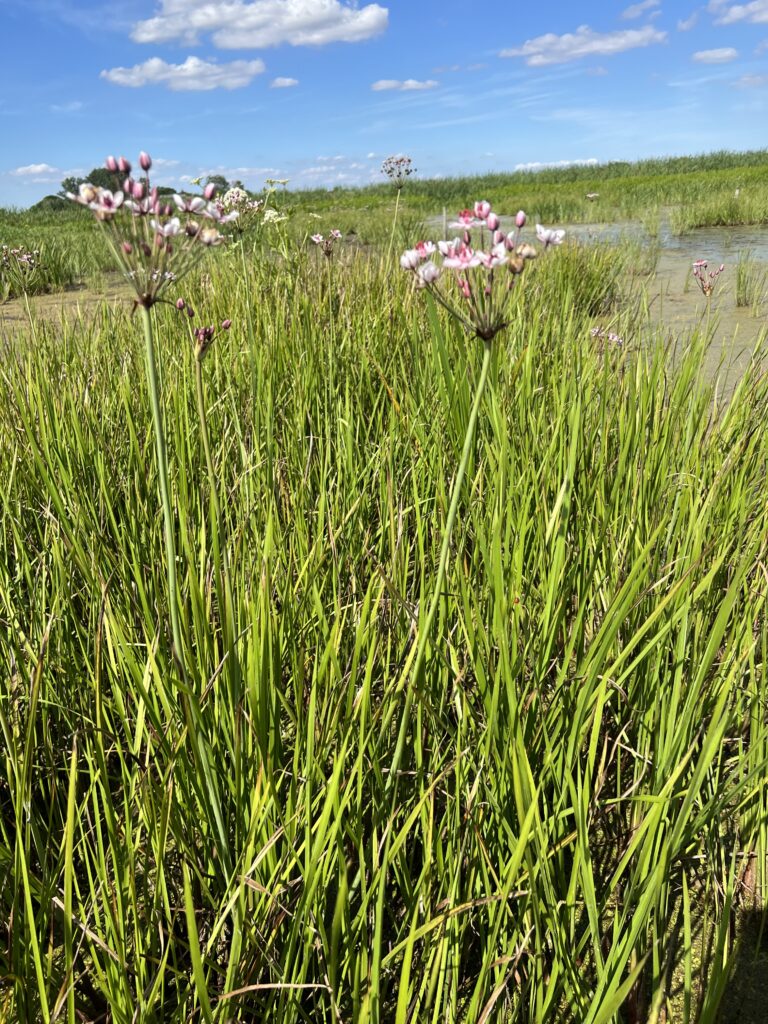by Rebecca Pool
Bog bodies and flood risks: Here’s what Europeans are getting wrong on wetlands.
Back in 2020, a grim picture of nature in the European Union emerged.
Only 15 per cent of key habitats including coasts, dunes, forests, grasslands and peatlands were in good condition according to the European Environment Agency.
Of these fragile ecosystems, peatlands – think bogs and fens, as well as mires – were among the worst affected.
The EU has since laid out its Nature Resolution Law with ambitious, continent-wide targets to improve and re-establish biodiverse habitats.
Hailed by many as a landmark biodiversity bill, EU member states finally reached political agreement on the law’s finer details on 10 November; good news for Europe’s peatlands and other precious wetlands.

Dr. Alexandra Barthelmes, from our partners at the University of Greifswald partner of the Greifswald Mire Centre
Photo credit: Dr. Alexandra Barthelmes, University of Greifswald partner of the Greifswald Mire Centre
Why are Europe’s wetlands in such a bad state?
Many wetlands were drained centuries ago to enable agricultural expansion, especially those in temperate climates. This has affected many of Europe’s migratory birds including ducks and geese, and mammals like otters and beavers who rely on wetlands for food.
But biodiversity – or a lack of it – is not the only problem. Intact wetlands store more carbon per unit of land area than any other ecosystem, while drained peatlands release carbon dioxide into the atmosphere.
Restoration is crucial to revive biodiversity and cut greenhouse gas emissions, but it’s not always straightforward. EU-funded research projects such as WET HORIZONS aim to make a difference by developing the knowledge base needed to restore the wetlands of Europe.
One challenge continues to be the age-old myths that Europe’s wetland experts still come up against.
Why do myths and legends surround wetlands?
From mangroves and seagrass beds to peatlands, reedbeds and grasslands, wetlands are not only inundated with water, but also mystery.
Bog bodies – naturally mummified human cadavers – have been getting dragged out of peatlands for decades, spreading fear among Europeans.
Dr Alexandra Barthelmes is a senior researcher at the University of Greifswald and Greifswald Mire Centre in Germany. She works alongside more than 50 passionate peatland scientists, many of whom are also involved in WET HORIZONS. Her team provides geographic information on Europe’s peatlands for the project.
“Many people believe it is dangerous to go to peatlands as they are worried that they will get there and just sink – but this is not true. You may sink in up to your knees, but you would have to work very hard to bury yourself.”
“Of the bog bodies found, many have had injuries and it seems others were sacrificed in some way,” she adds. “All the evidence indicates that most of the people were taken there on purpose as they simply didn’t ‘belong’ – so peatlands being these places of danger really is an age-old myth.”
Are wetlands really economic wastelands?
The danger of sinking to your death is just one of myriad myths that European wetland experts are now racing to dispel as they strive to restore these ecosystems.
Barthelmes is particularly keen to upend the notion that once wetlands are drained, they are gone forever.
For starters, most can be rewetted to once again become a wetland. Many researchers across Europe have spent years rewetting these regions and then applying ‘paludiculture’ – the climate-friendly and productive cultivation of rewetted peatlands. Much of their work contradicts this myth.
A case in point is the farming of Sphagnum, or peat moss, on degraded bog sites which have been drained for agricultural activities such as maize cultivation, cattle grazing, or for peat mining.
Barthelmes points to several successful pilot schemes underway across Lower Saxony in Germany.
“We’ve been able to spread shredded pieces of peat moss in formerly drained peatlands, with a lot of success,” she says. “And if Sphagnum is successfully reintroduced and the water table kept stable, we find that many other specific bog species return.”

Images (above and the featured header image) from a Deutsches GeoForschungs Zentrum (GFZ-Potsdam) wetland research site at Zarnekow, Germany.
Photo credit: Aram Kalhouri, Deutsches GeoForschungs Zentrum (GFZ-Potsdam)
Once established, the Sphagnum stores carbon, reducing carbon dioxide emissions, and also helps to prevent the release of pollutants into ground and surface water.
Meanwhile habitats for threatened species can be created. And if harvested the moss serves as a perfect substitute for the peat-based substrates still used by large- and small-scale farmers to grow vegetables.
This critical source of agricultural revenue also dispels a third common myth: that wetlands are doomed to become economic wastelands.
“The idea of paludiculture is to create new land use options that provide revenue [for farming] if wetlands are rewetted,” says Barthelmes. “And production of renewable biomass is very promising.”
Alongside growing Sphagnum, which can eventually be used as a peat soil alternative, other pilot schemes across Germany are experimenting with different biomass products on wetlands.
Reeds are being grown for use in construction boards that can replace plasterboard and also be used in thatched roofs. While cattail, a variety of the reed-like bullrush, is being cultivated for use as breathable and fireproof insulation.
In each case farmers can earn money from the sale of the biomass, the saved CO2 emissions and also from agricultural subsidies they may receive. For many paludiculture projects, the production chains are ready, making large-scale implementation the next critical step.
Are wetlands a flood risk?
Revenues aside, many perceive wetlands to be a flood risk, whereas the opposite is actually true.
Nature’s wetlands store flood water during storms, acting like natural sponges that soak up surface run-off and slowly release it later.
But once wetlands are drained to create farming land, with grassland replaced by crops such as wheat and maize, flooding risk rises. Factor in how fields are left bare over winter – drastically increasing surface water run-off – and drained regions can pose a real problem.
“Wetlands are only a flood-risk after they have been drained for [agricultural] use,” says Barthelmes.
The supposed wetland flood-risk is often considered to be a countryside problem only – with urban-dwellers safe from danger. Once again, a myth.
Barthelmes points to the many cities around Europe including Amsterdam, Rotterdam, Hamburg, Brussels, and Zurich, all of which have regions built on the porous, unstable ‘soft soils’ left behind from drained wetlands.
“If drained, the structure of the peat soil collapses and its organic matter oxidates [chemically degrades], leading to compaction,” she explains. As they get denser, “wetlands can then sink by up to several metres, making them at risk from flooding.”
“These shifting conditions highlight what we have done to the landscape, and must prompt us to think what to do next for living wetlands, and to also safeguard ourselves,” she adds.
Given the dire state of these precious habitats and issues that have ensued, researchers say it is time to put the wetland myths to rest.
Germany’s National Peatland Protection Strategy calls for annual peatland emissions to be reduced by five million tonnes of CO2 equivalents by the year 2030. Clearly the myth-busting can’t come a moment too soon.
The original article was published on euronews.org/green on 19.11.2023